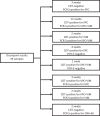A combined disk test for direct differentiation of carbapenemase-producing enterobacteriaceae in surveillance rectal swabs
- PMID: 23843486
- PMCID: PMC3754636
- DOI: 10.1128/JCM.00901-13
A combined disk test for direct differentiation of carbapenemase-producing enterobacteriaceae in surveillance rectal swabs
Abstract
Carbapenemase-producing Enterobacteriaceae (CPE) are rapidly spreading worldwide. Early detection of fecal CPE carriers is essential for effective infection control. Here, we evaluated the performance of a meropenem combined disk test (CDT) for rapidly differentiating CPE isolates directly from rectal swabs. The screening method was applied for 189 rectal swabs from hospitalized patients at high risk for CPE carriage. Swabs were suspended in 1 ml saline and cultured for confluent growth onto a MacConkey agar plate with a meropenem (MER) disk alone, a MER disk plus phenyl boronic acid (PBA), a MER disk plus EDTA, and a MER disk plus PBA and EDTA. An inhibition zone of ≤ 25 mm around the MER disk alone indicated carriage of carbapenem-resistant organisms. Furthermore, ≥ 5-mm differences in the inhibition zone between MER disks without and with the inhibitors (PBA, EDTA, or both) were considered positive results for detecting Klebsiella pneumoniae carbapenemase (KPC), metallo-β-lactamase (MBL), or both carbapenemases, respectively. For comparison, rectal suspensions were tested using MacConkey plates with ertapenem (MacERT) disks and PCR (PCR-S) for carbapenemase genes. Of the 189 samples, 97 were genotypically confirmed as CPE positive by one of the three protocols tested. The CDT, MacERT disks, and PCR-S assays exhibited sensitivities of 94.8%, 96.9%, and 94.8% and specificities of 100%, 98.9%, and 100%, respectively, for detecting CPE-positive swabs. Moreover, the CDT correctly differentiated the production of KPC, MBL, or both carbapenemases in 78 of the 97 (80.4%) CPE-positive rectal swabs. Our results demonstrate that the CDT may provide a simple and inexpensive method for detecting and differentiating the carbapenemase type within a single day without requiring further testing and additional delay, supporting the timely implementation of infection control measures.
Figures


References
-
- Carmeli Y, Akova M, Cornaglia G, Daikos GL, Garau J, Harbarth S, Rossolini GM, Souli M, Giamarellou H. 2010. Controlling the spread of carbapenemase-producing Gram-negatives: therapeutic approach and infection control. Clin. Microbiol. Infect. 16:102–111 - PubMed
-
- Centers for Disease Control and Prevention 2012. 2012 CRE Toolkit—guidance for control of carbapenem-resistant Enterobacteriaceae (CRE). CDC, Atlanta, GA: http://www.cdc.gov/hai/organisms/cre/cre-toolkit/index.html
-
- Gupta N, Limbago BM, Patel JB, Kallen AJ. 2011. Carbapenem-resistant Enterobacteriaceae: epidemiology and prevention. Clin. Infect. Dis. 53:60–67 - PubMed
-
- Schwaber MJ, Lev B, Israeli A, Solter E, Smollan G, Rubinovitch B, Shalit I, Carmeli Y, Israel Carbapenem-Resistant Enterobacteriaceae Working Group 2011. Containment of a country-wide outbreak of carbapenem-resistant Klebsiella pneumoniae in Israeli hospitals via a nationally implemented intervention. Clin. Infect. Dis. 52:848–855 - PubMed
-
- Ben-David D, Maor Y, Keller N, Regev-Yochay G, Tal I, Shachar D, Zlotkin A, Smollan G, Rahav G. 2010. Potential role of active surveillance in the control of a hospital-wide outbreak of carbapenem-resistant Klebsiella pneumoniae infection. Infect. Control Hosp. Epidemiol. 31:620–626 - PubMed
MeSH terms
Substances
LinkOut - more resources
Full Text Sources
Other Literature Sources
Research Materials
Miscellaneous

